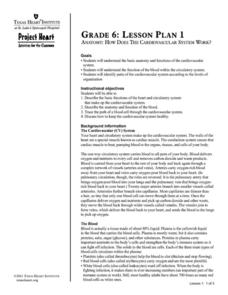Curated OER
Pollution and Lung Health
Learners investigate how pollution affects lung health. For this pollution and lung health lesson, students build lung models from a soda bottle and balloons, and then discuss how the emissions from fossil fuels can adversely affect lung...
Rochester Institute of Technology
Artificial Lung and Diaphragm
She had a terribly busy day converting oxygen into carbon dioxide; now she just needs a moment to breathe. In the activity, scholars review the function of the respiratory system and discuss bioengineering's role in medicine/health and...
Baylor College
Breathing Machine
Take a deep breath and have your class construct working models of a lung! Using 500ml plastic bottles as the chest cavity, and balloons for the lung and the diaphragm, learners work in groups to make a model. The models help them to...
Curated OER
How Can We Make a Model of Lungs?
Fifth graders examine the function of the lungs and create a model of the lungs. Using a plastic cup, drinking straw, plastic bag, small balloon, and a rubber band, they follow step-by-step directions to construct simulated lungs. ...
Curated OER
Pollution and Lung Health
Students study how lungs and a diaphragm work to make them breathe. In this pollution lesson students build a lung model and learn three things they can do to protect themselves from the effects of fossil fuels.
Nuffield Foundation
Modelling the Human Ventilation System
Why is breathing so difficult for asthma sufferers? To find out, learners build their own lung models in the investigation (from a British website, hence the term ventilation system instead of respiratory system). Using different-sized...
LABScI
Circulation and Respiration: Vital Signs
What do your vital signs tell your doctor? An engaging hands-on lesson plan has your learners monitor their own lung capacity, blood pressure, and heart rate. They then connect the vital measures to the workings of the circulatory and...
Curated OER
Lung Model
Learners create a simulated lung to explore its functions as part of the respiratory system.
Curated OER
Lungs: The Breathing Machine
Students create a model of the lungs and diaphragm. In this breathing lesson, students create a model out of a plastic bottle and balloons. They see how the diaphragm helps to fill the lungs with air.
Curated OER
Making a Model Lung
Learners explain the parts of the body that are involved in breathing and explore lung function. In this model lung activity students make a model of a lung then interpret and explain it.
Curated OER
TE Lesson: Out of Breath
Students study the parts of the human respiratory system while examining the gas exchange that takes place in the lungs. They make a model lung. They look at how the respiratory system is affected by spaceflight.
Curated OER
Making a Model Lung
Students build a model lung. In this life science instructional activity, students name the different parts of the lung and their function. They explain the process of breathing.
Curated OER
How Do We Breathe?
Students study the structure of the lungs. In this lung structure lesson, students use lung models to study the structure of lungs and experiment to measure the amount of air in the lungs.
Curated OER
The Magnificent Breathing Machine
Students discover their magnificent breathing machine. In this science lesson plan, students learn the functions of the lungs in our bodies and become aware that in breathing an exchange of gases takes place in the lungs.
Curated OER
The Human Body
Students make life-size models of their bodies by having a partner trace them. They glue the basic body parts in the proper places and decorate them with hair, and facial features.
Curated OER
How to Make a Model of the Human Respiratory System
Young scholars label parts of the human respiratory system on a diagram. They explain the function of diaphragm.
Curated OER
Obesity
Students examine how hormones affect different tissues. In groups, they make their own hormone-receptor model and identify the characteristics of tissues that respond to the different hormones. To end the lesson, they examine the role...
Curated OER
Nerve Cell Informercials
Students research the structure and function of the nervous system. They prepare a model or representation of neural transmission. Students create an infomercial about nerve cells.
Curated OER
Air Engine - Air Races
Students conduct an experiment about air volume, density, and pressure. For this air lesson, students discuss air, and how it moves. They make predictions about what will happen during the balloon and string experiment. They document the...
Texas Heart Institute
Anatomy: How Does the Cardiovascular System Work?
How can the circulatory system compare to a city map? Pupils distinguish the "roadways" and "vehicles" of the cardiovascular system, compare the anatomy and function of veins and arteries, and review different types of blood cells with...
Curated OER
The Journey of a Red Blood Cell
Fifth graders examine how a red blood cell travels throughout the body. Using a model, they recreate the flow of blood through the heart. They also label the lungs and the differece between the blood that enters the heart and the blood...
Curated OER
The Journey of a Red Blood Cell
Fifth graders examine how a red blood cell travels throughout the body. Using a model, they follow the flow of blood throughout the entire body. They identify the functions of the lungs and discuss the difference of the blood entering...
Tinybop
The Human Body
Examine the systems of the human body with a bold, charming, and kid-friendly application. This noteworthy tool is certain to get kids interested what goes on inside of them! The eye feature uses the tablet camera to view images and show...
Curated OER
Animal Classification
Second graders identify characteristics of and group animals by the five categories of vertebrates.

























